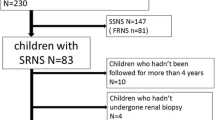Abstract
The clinical course of eight children with minimal change disease (MCNS) who were treated with cyclosporin (CYA) was retrospectively reviewed (group A). Five children had frequently relapsing (FRNS) and three had steroid-resistant (SRNS) primary nephrotic syndrome (PNS). The mean age (±SEM) of the patients at the time of initiation of CYA therapy was 8.01±1.30 years. Twelve follow-up renal biopsies, obtained from patients in group A, were compared with baseline 3.36±0.76 years after the initiation of CYA. Follow-up renal biopsies from group A were compared with another cohort of eight children with PNS who did not receive CYA (group B, controls). In this later group four children had FRNS and four had SRNS, and all had MCNS on the initial renal biopsy. In group B, the time between the initiation of CYA and the last renal biopsy was 4.07±0.82 years. All 36 baseline and follow-up renal biopsies, from group A and B, were retrospectively reviewed by the same pathologist who was blinded to the clinical course and therapy. CYA decreased the number of relapses in patients from group A from 5.20±1.02 to 1.14±0.63 episodes per year (P<0.05). All patients with SRNS went into remission after initiation of CYA. Estimated creatinine clearance before CYA therapy was unchanged at the end of the observation period, 133±10 vs. 131±8 ml/min per 1.73m2, respectively. One child developed reversible acute renal failure while on CYA therapy. Attempts to wean three patients off CYA after 3.89±0.87 years of CYA therapy were unsuccessful. Mild but increasing tubular atrophy and interstitial fibrosis was observed in serial biopsies of 75% of the patients in group A compared with 25% of the patients in group B, all of whom had MCNS on initial biopsy. In addition, the percentage of renal cortex showing interstitial fibrosis and tubular atrophy in biopsies from group A patients was slightly greater than that of the group B patients (P<0.05). Hence, CYA therapy in children with MCNS is associated with mild renal interstitial fibrosis and tubular atrophy similar to that noted in a minority of the patients with primary MCNS who were not treated with CYA. However, the mild chronic interstitial damage is more frequent and extensive in MCNS patients treated with CYA, suggesting drug-related interstitial alteration. Despite its efficacy and minimal nephrotoxicity in most patients with MCNS, CYA therapy carries the potential for significant morbidity.
Similar content being viewed by others
Author information
Authors and Affiliations
Additional information
Received: 22 September 1998 / Revised: 4 December 1998 / Accepted: 7 December 1998
Rights and permissions
About this article
Cite this article
Seikaly, M., Prashner, H., Nolde-Hurlbert, B. et al. Long-term clinical and pathological effects of cyclosporin in children with nephrosis. Pediatr Nephrol 14, 214–217 (2000). https://doi.org/10.1007/s004670050044
Issue Date:
DOI: https://doi.org/10.1007/s004670050044




